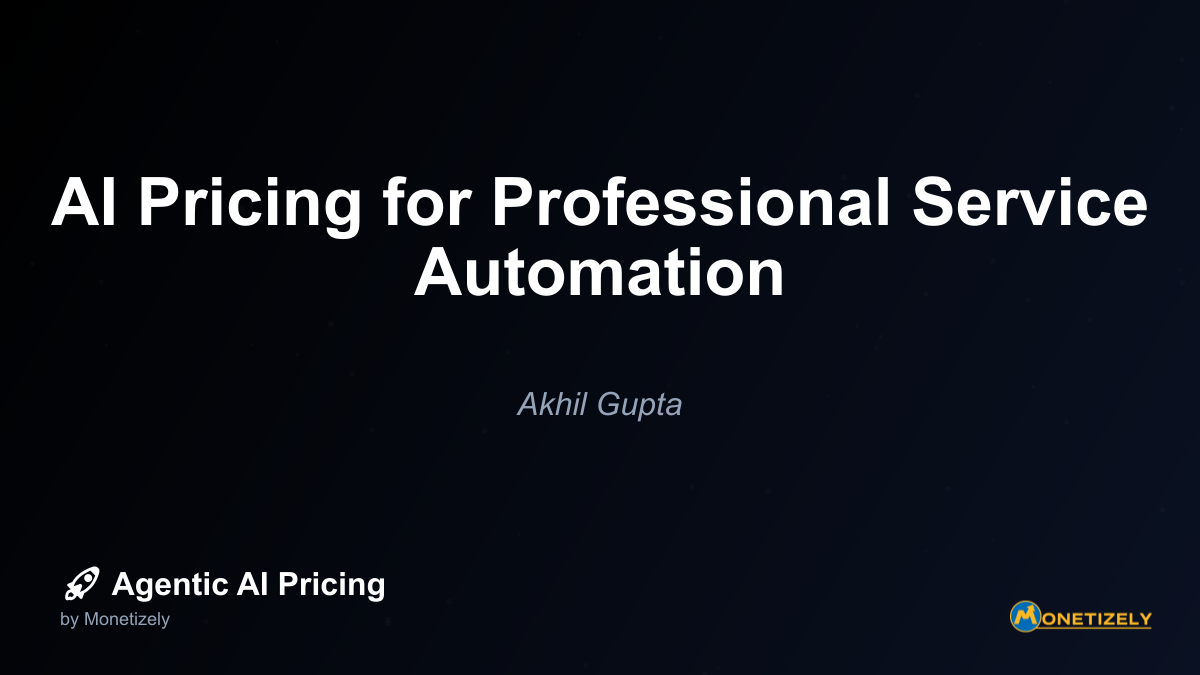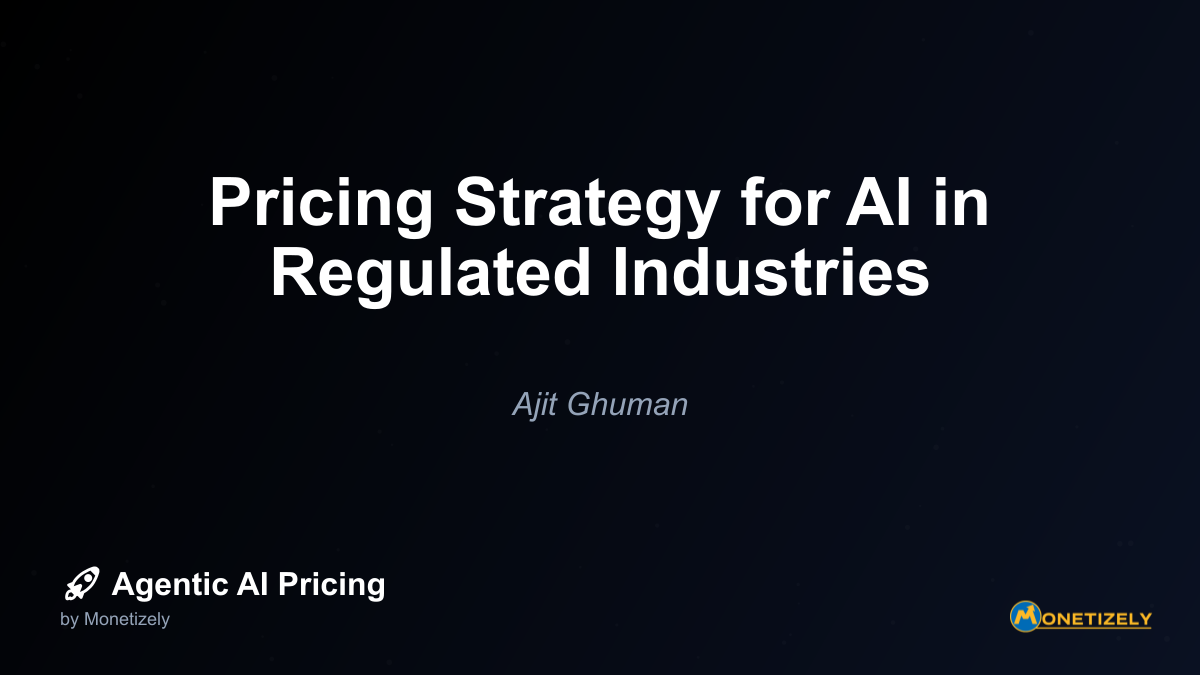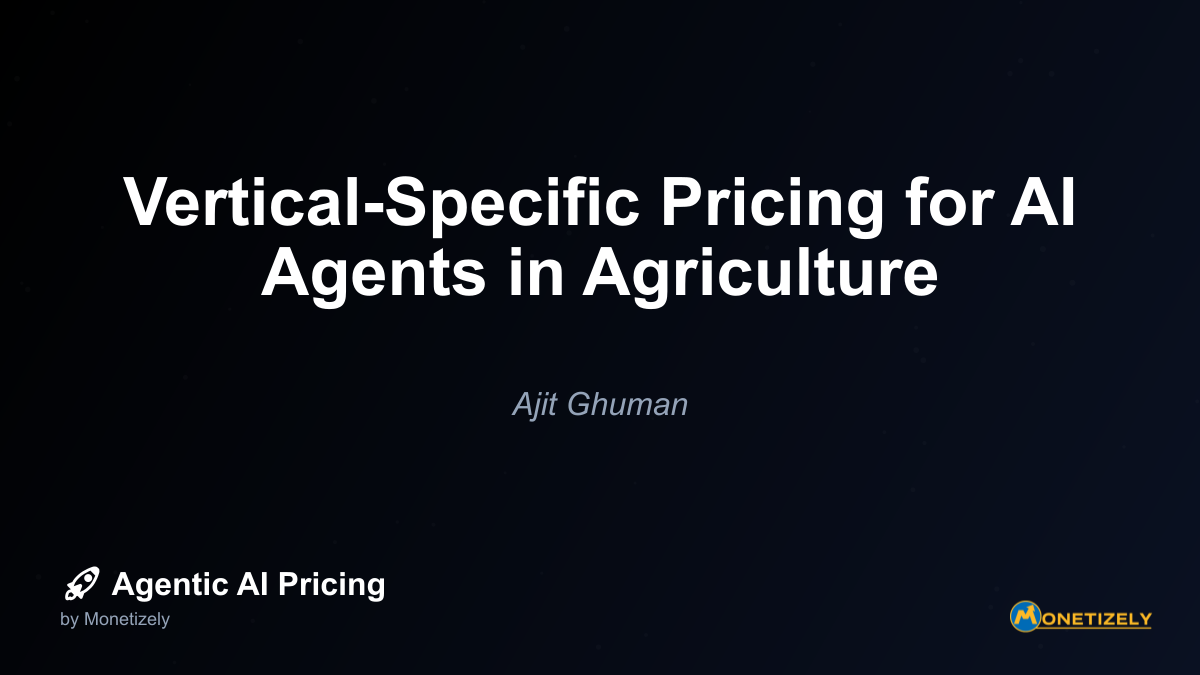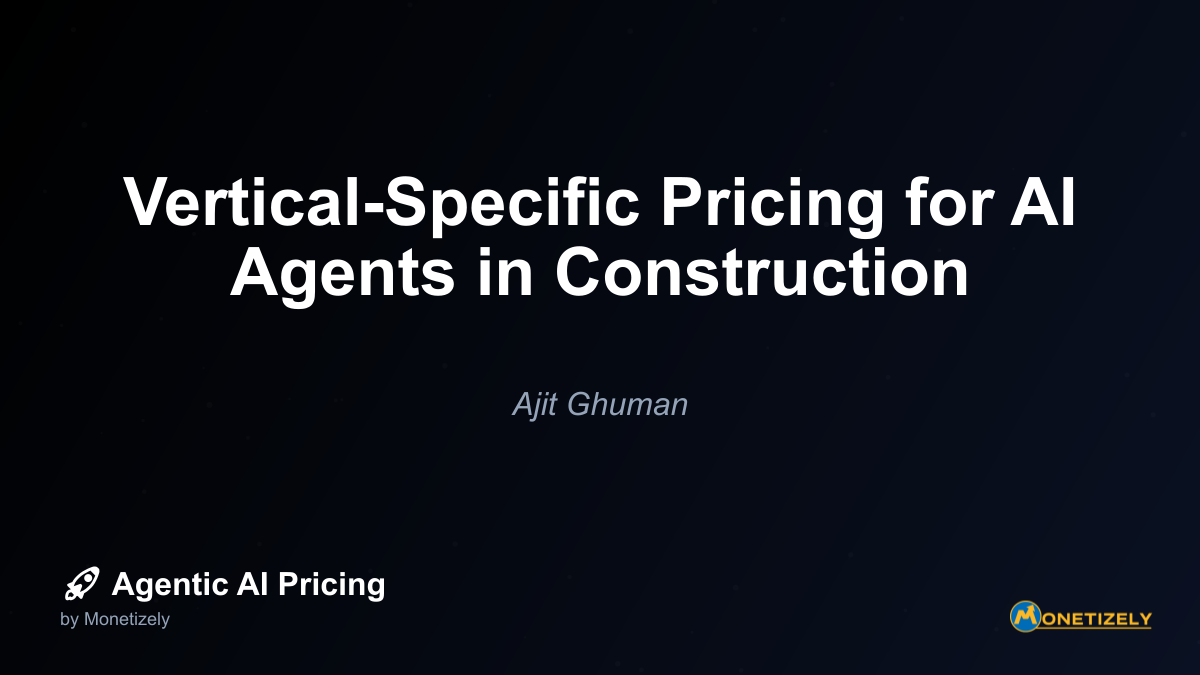· Ajit Ghuman · Industry-Specific · 13 min read
Vertical-Specific Pricing for AI Agents in Marketing
AI and SaaS Pricing Masterclass
Learn the art of strategic pricing directly from industry experts. Our comprehensive course provides frameworks and methodologies for optimizing your pricing strategy in the evolving AI landscape. Earn a professional certification that can be imported directly to your LinkedIn profile.
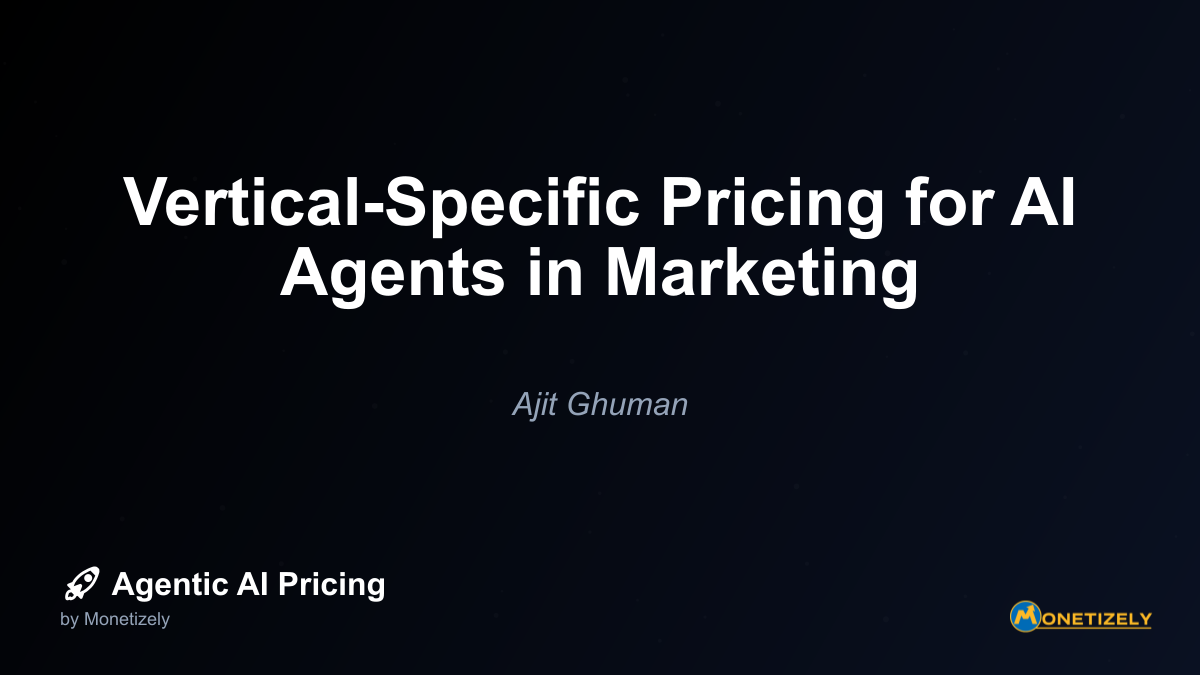
Marketing AI has fundamentally transformed how businesses approach customer acquisition, engagement, and retention. As organizations increasingly deploy AI agents for marketing functions, the question of how to price these sophisticated tools has become a critical strategic consideration. This deep dive explores the nuanced world of vertical-specific pricing for AI agents in marketing, with particular focus on attribution modeling, campaign optimization, and marketing automation.
The Evolution of Marketing AI Pricing Models
The marketing technology landscape has undergone a seismic shift with the integration of AI capabilities. Traditional pricing models based solely on seats or licenses are rapidly becoming obsolete as companies seek more sophisticated approaches that align costs with value delivered. This evolution reflects both the technological advancement of AI agents and the changing expectations of marketing organizations.
From Generic to Vertical-Specific Pricing
Early AI pricing models treated marketing applications the same as any other AI implementation. However, the industry has witnessed a decisive move toward vertical-specific pricing that accounts for the unique characteristics and value drivers of marketing use cases.
According to recent market research, 67% of enterprises now cite infrastructure spend as the primary barrier to growth in AI adoption, highlighting the need for pricing models that effectively manage computational costs while delivering demonstrable marketing ROI. This shift has been particularly pronounced in marketing applications where outcome measurement is more directly tied to revenue generation.
The Value Proposition of Marketing AI Agents
Marketing AI agents deliver value through multiple vectors:
- Efficiency gains through automation of repetitive tasks
- Enhanced decision-making through predictive analytics
- Improved personalization capabilities at scale
- More accurate attribution of marketing activities to business outcomes
- Optimized campaign performance through real-time adjustments
Each of these value streams presents unique pricing challenges and opportunities. As noted by Boston Consulting Group, “AI pricing strategies must evolve beyond simple usage metrics to capture the multidimensional value created for marketing organizations.”
Current Pricing Models for Marketing AI Applications
The landscape of pricing models for marketing AI applications has diversified significantly, with several frameworks emerging as dominant approaches in the market.
Output-Based Pricing
Output-based pricing ties costs directly to the AI-generated outputs that drive marketing functions. This model has gained traction because it creates a clear connection between AI usage and marketing deliverables.
Example implementations:
- Copy.ai charges approximately $0.02 per generated paragraph of marketing copy
- HubSpot employs a token system for AI-generated emails
- Jasper AI offers pricing based on the volume of content created for campaigns
This approach aligns pricing with tangible marketing assets produced by AI, making it easier for marketing departments to justify expenditures and track ROI. Research indicates that 41% of companies using output-based pricing reported higher customer satisfaction scores compared to those using traditional subscription models.
Token or Credit-Based Pricing
The token or credit-based model involves prepayment for discrete units of AI usage, providing transparency and scalability.
Key characteristics:
- Customers purchase tokens that can be applied to various AI features
- Pricing often includes volume discounts for bulk token purchases
- Usage is tracked and reported through dashboards
- Tokens may expire or roll over depending on contract terms
HubSpot’s AI Assistant exemplifies this approach, offering bulk discounts on token purchases and providing detailed dashboards that give marketing and finance teams visibility into AI-related marketing spend and utilization. This model has proven particularly effective for enterprises that need to control and predict costs while still accessing advanced AI capabilities.
Usage/Resource-Based Pricing
This model charges based on the underlying computational resources consumed by marketing AI applications.
Implementation examples:
- OpenAI and Anthropic offer consumption-based token pricing for language models used in marketing applications
- Google’s Performance Max and Meta’s Advantage+ utilize resource-based pricing for campaign optimization
- Many marketing analytics platforms charge based on data volume processed
While this approach offers flexibility, it often presents challenges for budget predictability, which is critical for enterprise marketing budgets. Only 23% of enterprises report being able to accurately forecast AI spend on a monthly basis, highlighting a significant pain point with pure usage-based models.
Agent-Based Pricing
A growing trend involves pricing based on specific AI agents that perform discrete marketing tasks. This model mirrors the salary costs for equivalent human roles, offering predictable spend while effectively commoditizing AI labor.
Examples in the market:
- Campaign optimization agents priced as monthly subscriptions
- Customer engagement agents with fixed licensing fees
- Attribution modeling agents with tiered pricing based on complexity
This approach resonates with marketing executives who are accustomed to thinking about team structure and headcount costs. It provides a familiar framework for evaluating AI investments and integrating them into existing organizational structures.
Hybrid Pricing Models
Perhaps the most sophisticated approach, hybrid pricing combines elements of multiple models to balance predictability with value capture. According to recent industry data, 41% of AI companies now employ hybrid pricing models, up from 28% in 2023.
Common hybrid approaches:
- Base subscription plus usage components
- Tiered feature access with consumption-based overages
- Outcome-based pricing with minimum commitments
- Fixed core services with add-on AI capabilities
Hybrid models are particularly well-suited to marketing applications where value is derived from both ongoing access to capabilities and variable usage patterns. Companies like Jasper AI, Notion AI, and Fireflies.ai combine flat-rate add-ons or seat plans to simplify pricing while embedding AI into marketing workflows without billing complexity.
Attribution Modeling: Pricing for Complexity and Value
Attribution modeling represents one of the most sophisticated applications of AI in marketing, and its pricing reflects this complexity.
The Attribution Challenge
Marketing attribution has always been a challenging area, but AI has transformed what’s possible. Advanced AI agents can now track customer journeys across channels, attribute value to touchpoints, and provide insights that were previously unattainable. This capability comes with significant computational requirements and data processing needs.
Current Attribution AI Pricing Approaches
The pricing of AI-powered attribution systems typically follows several patterns:
- Tiered complexity pricing - Basic, intermediate, and advanced attribution models at different price points
- Data volume pricing - Costs scale with the amount of marketing data processed
- Channel integration pricing - Additional fees for each marketing channel integrated
- Custom model development - Premium pricing for bespoke attribution algorithms
Leading providers like Google Analytics 4, Adobe Analytics, and specialized attribution platforms each take slightly different approaches to pricing their AI capabilities.
Case Study: Enterprise Attribution Pricing
A Fortune 500 retailer implemented an advanced AI attribution system with a hybrid pricing model:
- Base platform fee: $150,000 annually
- Per-channel integration: $25,000 annually per channel
- Data processing: Tiered based on volume with predictable monthly costs
- Custom model development: One-time fee of $75,000
This structure allowed the company to start with core attribution needs and scale as they integrated more channels and data sources. The ROI justification came from a 23% improvement in marketing spend efficiency within the first six months, representing over $3.2 million in savings.
Campaign Optimization: Performance-Based Pricing Models
AI-driven campaign optimization represents one of the clearest use cases for value-based pricing, as outcomes are directly measurable in terms of campaign performance improvements.
Value Metrics for Campaign Optimization
The pricing of campaign optimization AI typically anchors to specific performance improvements:
- Reduced Cost Per Acquisition (CPA) - Pricing tied to percentage improvements in acquisition costs
- Increased Conversion Rates - Fees scaled based on conversion lift
- ROAS Improvements - Pricing aligned with Return On Ad Spend enhancements
- Engagement Uplift - Costs based on improvements in engagement metrics
According to recent studies, businesses are achieving significant CPA improvements (around 30%) by shifting from manual audience targeting to AI-optimization in advertising campaigns, providing clear justification for premium pricing.
Competitive Landscape in Campaign Optimization
The campaign optimization space features several major players with distinct pricing approaches:
| Company | Pricing Model | Key Differentiators | Target Segment |
|---|---|---|---|
| Google Performance Max | Usage-based with minimums | Cross-channel optimization, extensive data integration | Mid-market to enterprise |
| Meta Advantage+ | Performance-based | Social-focused, creative optimization | SMB to enterprise |
| AdCreative.ai | Tiered subscription + usage | Creative generation focus | SMB to mid-market |
| Albert AI | Performance fee + management fee | Full-service automation | Mid-market to enterprise |
| Pencil | Output-based | Video and creative optimization | Mid-market |
This diversity of approaches reflects the varied needs of marketing organizations and the different value propositions offered by campaign optimization tools.
Case Study: Performance-Based Pricing Success
A direct-to-consumer brand implemented a performance-based pricing model with their campaign optimization AI vendor:
- Base platform access: $5,000 monthly
- Performance fee: 15% of documented spend efficiency improvements
- Minimum commitment: 6 months
This structure aligned incentives between the vendor and client, resulting in a 27% improvement in ROAS and a 22% reduction in CPA. The brand’s CMO noted, “The performance-based component gave us confidence that the AI provider was invested in our success, not just selling us access to their technology.”
Marketing Automation: The Tiered Feature Approach
Marketing automation represents the broadest category of AI applications in marketing, encompassing everything from email sequence optimization to customer journey orchestration. This breadth is reflected in the complexity of pricing models.
Common Pricing Structures for Automation AI
The pricing of AI-enhanced marketing automation typically follows several patterns:
- Contact-based pricing - Costs scale with database size
- Feature-tiered pricing - Basic, standard, and advanced AI capabilities at different price points
- Activity-based pricing - Costs tied to automation workflows executed
- Hybrid models - Combinations of the above approaches
Major platforms like HubSpot, Marketo, and Salesforce have all integrated AI capabilities into their marketing automation offerings, with pricing that reflects both the traditional SaaS components and the added value of AI.
AI as a Premium Feature
Many established marketing automation platforms position AI capabilities as premium features with corresponding pricing models:
- Base platform access at standard SaaS pricing
- AI capabilities as add-ons with separate pricing
- Usage limits on AI features within each tier
- Premium support for AI implementation
This approach allows vendors to capture the additional value created by AI while providing customers with flexibility in how they adopt and scale these capabilities.
Case Study: Tiered AI Automation Pricing
A B2B technology company adopted a marketing automation platform with the following AI pricing structure:
- Base platform: $4,500 monthly for 25,000 contacts
- AI add-on package: $2,000 monthly for predictive lead scoring, content optimization, and send-time optimization
- Additional AI credits: $500 per 100,000 credits for generative content creation
This structure allowed the company to start with core automation needs and add AI capabilities as they demonstrated value. The initial investment in AI features resulted in a 32% increase in email engagement and a 17% improvement in lead quality, justifying the premium pricing.
Technical Factors Influencing Marketing AI Pricing
Several technical considerations significantly impact how marketing AI applications are priced and the value they deliver.
Computational Intensity and Infrastructure Costs
Marketing AI applications vary widely in their computational requirements:
- Generative content creation - High computational intensity, especially for multimodal content
- Predictive analytics - Moderate to high, depending on data volume and model complexity
- Real-time optimization - High intensity with low latency requirements
- Attribution modeling - Data-intensive with moderate computational requirements
These differences in resource needs directly influence pricing structures. As one industry expert noted, “The computational costs of running sophisticated marketing AI models can easily exceed $10,000 monthly for enterprise-scale applications, necessitating pricing models that account for these backend expenses.”
Data Integration Complexity
The value of marketing AI is directly tied to the breadth and depth of data it can access. This creates pricing considerations around data integration:
- Number of marketing channels integrated
- Volume of historical data processed
- Frequency of data refreshes
- Custom data source connections
Many vendors charge additional fees for complex integrations or high data volumes, reflecting the increased value and cost of comprehensive data access.
Model Training and Customization
Generic AI models rarely deliver optimal results for specific marketing use cases. Customization and training create additional value and costs:
- Custom model development fees
- Ongoing model retraining costs
- Domain-specific optimization charges
- Proprietary algorithm premiums
These factors often appear as one-time setup fees or premium tiers in marketing AI pricing structures.
Measuring ROI to Justify Marketing AI Investments
The sophisticated pricing of marketing AI applications necessitates equally sophisticated approaches to measuring and justifying ROI.
Attribution Improvements
AI-powered attribution itself becomes a tool for justifying other AI investments:
- More accurate channel attribution leading to improved budget allocation
- Identification of previously undervalued touchpoints
- Reduced wasted spend on ineffective channels
- More precise customer journey mapping
Companies report attribution improvements of 20-35% when implementing AI-driven models compared to traditional approaches.
Efficiency Gains
Automation and optimization drive significant efficiency improvements:
- Reduced time spent on routine marketing tasks
- Faster campaign iteration and optimization
- Lower headcount requirements for campaign management
- Improved team productivity on strategic initiatives
These efficiency gains often translate directly to cost savings or increased output with existing resources.
Performance Enhancements
Perhaps the most direct ROI measurement comes from campaign performance improvements:
- Reduced customer acquisition costs (typically 15-30%)
- Increased conversion rates (often 10-25%)
- Improved customer lifetime value (varies by industry)
- Enhanced engagement metrics across channels
These metrics provide clear financial justification for AI investments when properly tracked and attributed.
Case Study: Comprehensive ROI Measurement
A multi-channel retailer implemented a comprehensive approach to measuring their marketing AI ROI:
- Baseline performance metrics established before AI implementation
- Controlled A/B testing comparing AI-optimized vs. traditional campaigns
- Total cost of ownership analysis including platform fees, integration costs, and team time
- Quarterly ROI reviews with finance and marketing leadership
This approach demonstrated a 287% ROI on their marketing AI investments within the first year, with improving returns as the AI systems gained more data and optimization opportunities.
Enterprise Adoption Challenges and Solutions
Despite the clear value proposition, enterprises face several challenges when adopting and scaling marketing AI applications.
Integration with Existing Martech Stacks
Marketing technology ecosystems are often complex and fragmented, creating integration challenges for new AI tools:
Challenges:
- Legacy systems with limited API capabilities
- Data silos preventing comprehensive analysis
- Workflow disruptions during implementation
- Technical debt in existing marketing platforms
Solutions:
- Middleware and integration platforms
- Phased implementation approaches
- API-first AI tools designed for ecosystem integration
- Vendor professional services for custom integrations
Skills and Knowledge Gaps
Marketing teams often lack the technical expertise to fully leverage AI capabilities:
Challenges:
- Limited understanding of AI capabilities and limitations
- Insufficient data science expertise
- Difficulty interpreting AI insights and recommendations
- Resistance to automation of traditional marketing functions
Solutions:
- Embedded training and enablement
- AI tools with intuitive interfaces
- Guided implementation processes
- Change management programs
Data Quality and Governance
AI performance is directly tied to data quality, creating significant adoption hurdles:
Challenges:
- Incomplete or inaccurate customer data
- Inconsistent tracking across channels
- Privacy and compliance concerns
- Data governance limitations
Solutions:
- Data cleansing and preparation services
- Progressive implementation based on data readiness
- Privacy-by-design approaches
- Governance frameworks aligned with AI needs
Future Trends in Marketing AI Pricing (2025 and Beyond)
The pricing landscape for marketing AI continues to evolve rapidly, with several clear trends emerging for the coming years.
Increased Value-Based Pricing
As AI capabilities mature and their impact becomes more measurable, pricing will increasingly tie directly to business outcomes:
- Revenue share models based on incremental gains
- Performance guarantees with risk-sharing components
- Success-based pricing tied to specific marketing KPIs
- Value-capture mechanisms that scale with results
This shift aligns vendor incentives more closely with customer success, potentially reducing upfront costs while increasing total contract value for successful implementations.
Democratization and Commoditization
Certain AI capabilities are becoming standardized and commoditized, driving changes in pricing:
- Basic AI features included in standard marketing platforms
- Premium pricing reserved for cutting-edge capabilities
- Decreasing costs for computational resources
- Open-source alternatives for common AI functions
This trend may create pricing pressure for established vendors while opening opportunities for specialized providers with unique capabilities.
Ecosystem Integration Pricing
As marketing AI becomes more deeply integrated with broader technology ecosystems, pricing models will evolve:
- Bundle pricing across marketing, sales, and customer service AI
- Integration-based pricing reflecting ecosystem value
- Platform fees replacing point solution pricing
- Value-sharing across ecosystem partners
This approach recognizes that the value of marketing AI is maximized when it connects seamlessly with other business systems and processes.
Predictive and Dynamic Pricing
AI itself is transforming pricing models through advanced analytics and dynamic approaches:
- Predictive pricing based on expected customer value
- Dynamic pricing adjusted to market conditions
- Personalized pricing reflecting individual customer needs
- AI-optimized pricing structures maximizing vendor and customer value
As one industry analyst noted, “The future of marketing AI pricing is AI-driven pricing itself, creating a virtuous cycle of optimization and value creation.”
Competitive Analysis: Major Players in Marketing AI
The competitive landscape for marketing AI is diverse, with players ranging from established marketing platforms to specialized AI providers.
Enterprise Marketing Platforms
Major marketing platforms have integrated AI capabilities with varying pricing approaches:
| Platform | AI Capabilities | Pricing Approach | Key Differentiators | |----------|----------------|------------------|
Co-Founder & CEO
Ajit is the author of Price To Scale, a top book on SaaS Pricing and is the Founder of Monetizely. Ajit has led and worked in pricing and product marketing at firms like Twilio, Narvar and Medallia. His work has been featured in Forbes and VentureBeat. Ajit regularly consults with software companies from Seed stage to post-IPO on pricing strategy. Ajit is also a highly-rated co-instructor for 'The Art of SaaS Pricing and Monetization' on Maven.
Pricing Strategy Audit
Let our experts analyze your current pricing strategy and identify opportunities for improvement. Our data-driven assessment will help you unlock untapped revenue potential and optimize your AI pricing approach.

